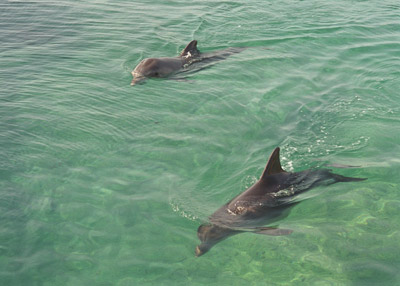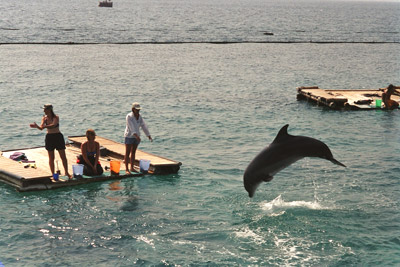When Snorkelling, Keep Your Smiles To Yourself
When snorkelling, keep your smiles to yourself
BY LAURA GOLDSTEIN – Eilat, Israel
I confess that I’ve always wanted to snorkel with the dolphins. That’s what happens when you grow up watching the invariably smiling Flipper on TV.
When we visited Dolphin ReefDolphin Reef in Eilat in Eilat, my first foray into exploring the mysteries of the Red Sea, I learned two things: First, never smile back when you see a dolphin and, second, after four days at Herods Palace Hotel, wetsuits are not that slenderizing, even in basic black.
 Dolphin Reef resembles a Swiss Family Robinson attraction for the general public. Its three-tiered observation deck of weathered wood and ropes, with a scuba diving and snorkelling outpost, outdoor showers, snack bar and picnic area on a private beach, gives an island- castaway-feel to the place.
Dolphin Reef resembles a Swiss Family Robinson attraction for the general public. Its three-tiered observation deck of weathered wood and ropes, with a scuba diving and snorkelling outpost, outdoor showers, snack bar and picnic area on a private beach, gives an island- castaway-feel to the place.
Dolphin Reef is not only a tourist attraction; it’s also an international research lab dedicated to the study of these fascinating mammals.
It was created 10 years ago by the husband-and-wife team of Roni and Maya Zilber, whose research into dolphin behaviour, signal learning and early socialization is guided by an international board of scientists.
The Zilbers and their team of 15 divers, guides and keepers wanted to protect the dolphins within a natural habitat, so Dolphin Reef follows a “freedom to choose” philosophy. Although the compound is gated in the Red Sea, barriers are opened throughout the day and the 13 bottlenose dolphins, including the nine babies born at the site, can freely choose to stay or swim out to the open sea. It is interesting to note that the four adult dolphins always stay within the compound and the youngsters enjoy exploring the world outside.
Here, too, visitors can snorkel or dive with the dolphins, accompanied by an experienced guide. We opt to go snorkelling.
After suiting up, we are given a short talk about the dolphins and how their delightful curiosity and intuitive affinity for humans mimics their own routines of socializing with each other. Our guide, a Frenchwoman named Babette, stresses that the dolphins will come to us; that interaction must be spontaneous and under no circumstances do we feed, ride or chase them. She also emphasizes that if they allow us to touch them, their faces and genitals are out of bounds.
 A photographer with an underwater camera will be snorkelling with us to capture our expressions when we encounter the dolphins.
A photographer with an underwater camera will be snorkelling with us to capture our expressions when we encounter the dolphins.
We are particularly excited about the possibility of seeing a three-day-old white baby dolphin named Luna who never leaves her mother’s side. Both have remained at a distance from snorkellers and divers, so we try not to get our hopes up.
Babette leads us into the sea. Just off shore, the Red Sea suddenly drops to a precarious 14 metres and we start to hear the dolphins communicating underwater. Having little sense of direction even on dry land, I stay very close to Babette, anticipating dolphins at any second.
Suddenly, Luna and her mother sweep by us and I am so startled and overcome with awe that I instinctively smile broadly at them. Big mistake! Salt water fills my mouth and mask and I’m sputtering for air. My face is so contorted from struggling to keep my contact lenses in and keep breathing that the photographer swims away realizing this isn’t exactly a Kodak moment. Back on the surface, Babette tells me that people with high cheekbones have problems with their masks fitting properly (what a diplomat!) and promptly switches my mask with hers. She also tells me not to smile at the dolphins — that loosens the snorkel and makes my mask leak. (I try to remember to keep my mouth shut underwater and start again.)
Another dolphin glides by and my husband reaches out and gently caresses the side of its body. It abruptly swims off and the murky depths seem to swallow it up.
Wading back to shore we are exhilarated and profoundly moved. And now I can enjoy reruns of Flipper with a new respect.
IF YOU GO:
Getting there:
– Air Canada and El Al fly to Tel Aviv from Toronto direct or with a stopover in Montreal. Check with your travel agent; flight prices vary substantially throughout the year.
– Two Israeli airlines, Arkia and Israir, have frequent, regularly scheduled flights to Eilat from Tel Aviv, Jerusalem, Haifa and Be’er Sheba. The 50-minute flight costs about $250 return.
– Car rentals and gas (by law, all vehicles are air-conditioned) are very expensive in Israel, about $80 per day. It is a five-hour drive from Tel Aviv to Eilat if you wish to see the beautiful Negev desert or take a side trip to the Dead Sea. Highways are excellent; the drivers are not. If you dare to drive, be prepared for speeding and excessive tailgating.
Dolphin Reef
– From the centre of Eilat, take a short drive south along Arava Road and you will find Dolphin Reef on the shore between the port and Coral Beach. Or simply flag down a cab — it’s a quick $3 to $5 taxi ride from any hotel.
– Snorkelling costs about $100 per person; diving is more expensive. Both include use of all equipment. Diving lessons are available for adults and children 10 and over. Reservations are a must, especially during peak summer periods.
The writer thanks El Al Airlines and was a guest of Herod’s Hotel
